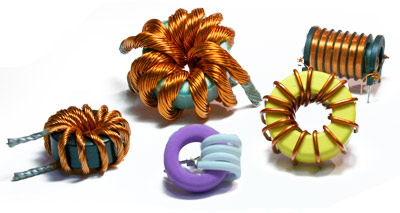Toroidal Transformers, Filter & Coils
Applications:- HF – Transformer for SMPS (Switching Mode Power Supplies).
- Energy Storage Chokes.
- EMC Filters.
- Ignition Coils.


Toroidal Transformer
As the high performers among transformers, toroidal transformer offer the smallest size (by weight and volume), less leakage inductance, and lower electromagnetic interference (EMI). The proportionally larger surface area cause their windings cool better. A 360 degree wound toroidal transformer has a high degree of symmetry. Its geometry leads to near complete magnetic field cancellation outside of its coil, hence the toroidal transformer has less leakage inductance and less EMI when compared against other transformers of equal power rating.
Toroidal transformers with a round core cross section are better performers than toroidal transformers with a rectangular cross section. The cancellation is more complete for the round cross section. The round cross section also gives a shorter turn length per unit of cross sectional area, hence lower winding resistances.
The toroidal transformer also has better winding to winding magnetic coupling because of its toroidal shape. The coupling is dependent on the winding being wound a full 360 degrees around the core and wound directly over the prior winding, hence sector wound windings do not couple as well and have higher leakage inductance. As winding turns are positioned further away from the core less complete coupling will occur; hence toroidal transformers with multi-layered windings will exhibit more leakage inductance.
Toroidal transformers can be used in any electronic transformer application that can accommodate its shape. Although usable, toroidal transformers are not always practical for some applications. Gapped toroidal transformers usually require that the gap be filled with some type of insulating material to facilitate the winding process. This is an extra expense. Split core current transformers can be assembled directly on a conductor while toroids must be passed over a disconnected end of the conductor. A toroid can be split in two, but a suitable clamping mechanism (difficult and costly) is required.
Some printed circuit boards are space critical. Mounting a toroidal transformer flat on the board may take up too much precious board area. Some applications also have restricted height so the toroid cannot be mounted vertically.
Generally speaking toroidal transformers are more expensive than bobbin or tube wound transformers. Sufficient winding wire must first be wound (loaded) onto the winding shuttle, then wound onto the toroidal transformer’s core. After that, the best situation, from a cost perspective, is no insulation required over the winding and the next winding uses the same wire size. If the wire is different, then the leftover wire must be removed and the wire for the next winding must be loaded.
However, if the winding must be insulated, then if must either be insulated (taped) by hand or the toroidal transformer must be removed and taken to a separate taping machine, then placed back on the toroid winding machine after taping. The shuttle must then be loaded with the wire size and type for the toroidal transformer’s next winding.
A toroidal transformer with a single winding (autotransformer, current transformer) wound on a coated core will probably be cost competitive with an equivalent bobbin or tube wound transformer since the toroidal transformer will not require a bobbin or tube. The cost differential will then depend on the method and cost of mounting the transformers.
Toroidal transformer cores are available in many materials: silicon steel, nickel iron, moly-permalloy powder, iron powdered, amorphous, ferrites, and others. Silicon steel and nickel iron are available as tape wound cores or laminated pieces. Non-magnetic toroids are also available to make air core toroidal transformers. PT. Induktorindo Utama manufactures toroidal transformers in a wide variety of materials and sizes.
Filter
To remove unwanted signal components from an input signal and/or enhance wanted ones / to select a desired signal components among many others.Coils
An Induction coil or "spark coil" is a type of disruptive discharge coil. It is a passive electrical device used to produce high-voltage pulses from a low-voltage DC supply.
An induction coil consists of two coils of insulated copper wire wound around a common iron core. One coil, called the primary, is made using tens or hundreds of turns of coarse wire. The other coil, called the secondary, typically consists of many thousands of turns of fine wire.
In operation, an electric current is passed through the primary, creating a magnetic field. Because of the common core, most of the primary's magnetic field also couples to the secondary winding. The primary behaves as an inductor, storing energy in the associated magnetic field. When the primary current is suddenly interrupted, the magnetic field rapidly collapses. This causes a high voltage pulse to be developed across the secondary terminals through electromagnetic induction. Because of the large number of turns in the secondary coil, the secondary voltage pulse is typically many thousands of volts. This voltage is often sufficient to cause an electrical discharge, or spark, to jump across an air gap separating the secondary output terminals. For this reason, induction coils were sometimes called spark coils.
Most induction coils utilized a magnetically activated vibrating arm to rapidly connect and break current flowing into the primary coil. The term "Induction coil" is also used for a coil carrying high-frequency AC and intended to induce eddy currents to heat objects placed in the interior of the coil, such as in induction heating or zone melting.
An ignition coil (also called a spark coil) is an induction coil in an automobile's ignition system which transforms the battery's 12 volts (6 volts in some older vehicles) to the thousands of volts needed to spark the spark plugs. This specific form of the autotransformer, together with the contact breaker, converts low voltage from a battery into the high voltage required by spark plugs in an internal combustion engine.
Air Coil
Various air coils, which covers models like “just air inside” as well as windings upon a different insulator such as glass, PTFE, etc.
